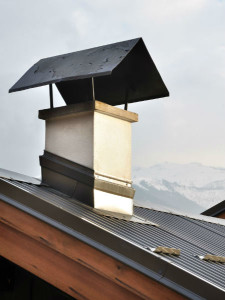While the firebox might be the part of your fireplace system that you are most familiar with, the entire system if full of different components that all work together to help your fireplace burn safely and efficiently. Understanding the different parts of your chimney system and their purpose can help you feel more confident operating your fireplace as well as better recognize maintenance issues when they arise.
The following are some of the most important parts of your chimney. By learning about your chimney’s anatomy, you can feel better prepared to understand and deal with any maintenance issues or repairs in the future.
Chimney cap

Chimney caps cover and protect the top of the flue. With a metal cover and mesh sides, chimney caps prevent water, animals, and debris from falling or blowing into the flue.
Chimney crown
The chimney crown is the concrete or masonry slab that seals the top of the chimney; the chimney cap sits on top of the crown. Chimney crowns are susceptible to moisture damage which can cause the concrete to crack or chip away.
Chimney chase cover
Chimney chase covers are only found on prefabricated or factory built chimneys. Chase covers, typically made of metal such as stainless steel, are similar to chimney crowns in that they seal and protect the top of the chimney and flue. Because they are made of metal, however, they are more susceptible to water damage. Rust stains on the side of a prefabricated chimney are signs that the chase cover has begun to deteriorate.
Damper
The chimney damper is used to close off the firebox from the rest of the flue while the fireplace is not in use. Opened and closed using a lever or pulley, dampers minimize drafts and can prevent conditioned air from escaping up the chimney. While most homes have throat dampers which are located at the top of the firebox, more and more homeowners are installing top mounted dampers; placed at the top of the flue, top mounted dampers seal off the entire chimney from the outside.
Flue and flue liner
The flue is the interior portion of the chimney through which smoke and gas vent upwards. The flue liner coats the inside of the flue and protects the surrounding building materials from exposure to heat, smoke, or gas. Flue liners can deteriorate over time or be damaged, in which case your chimney may need to be
relined.
Smoke chamber
The smoke chamber helps compress and vent smoke and hot air upwards into the flue. Located just above the firebox, smoke chambers have sloping walls to help the byproducts of combustion quickly and easily vent upwards.
Smoke shelf
Located behind the throat damper in between the firebox and the smoke chamber, the smoke shelf is used to catch any embers, ash, or other debris that may be travelling up into the flue.
By learning more about your chimney system, you can better understand the dynamics that help your fireplace to function safely and efficiently. If you have questions about the anatomy of your chimney, contact Mason’s Chimney Service today!

